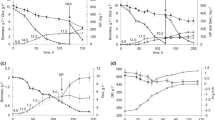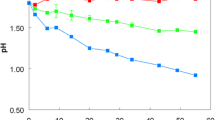Abstract
The mutualistic interactions in a 4-aminobenzenesulfonate (sulfanilate) degrading mixed bacterial culture were studied. This coculture consisted of Hydrogenophaga palleronii strain S1 and Agrobacterium radiobacter strain S2. In this coculture only strain S1 desaminated sulfanilate to catechol-4-sulfonate, which did not accumulate in the medium but served as growth substrate for strain S2. During growth in batch culture with sulfanilate as sole source of carbon, energy, nitrogen and sulfur, the relative cell numbers (colony forming units) of both strains were almost constant. None of the strains reached a cell number which was more than threefold higher than the cell number of the second strain. A mineral medium with sulfanilate was inoculated with different relative cell numbers of both strains (relative number of colony forming units S1:S2 2200:1 to 1:500). In all cases, growth was found and the proportion of both strains moved towards an about equal value of about 3:1 (strain S1:strain S2). In contrast to the coculture, strain S1 did not grow in a mineral medium in axenic culture with 4-aminobenzenesulfonate or any other simple organic compound tested. A sterile culture supernatant from strain S2 enabled strain S1 to grow with 4-aminobenzenesulfonate. The same growth promoting effect was found after the addition of a combination of 4-aminobenzoate, biotin and vitamin B12. Strain S1 grew with 4-aminobenzenesulfonate plus the three vitamins with about the same growth rate as the mixed culture in a mineral medium. When (resting) cells of strain S1 were incubated in a pure mineral medium with sulfanilate, up to 30% of the oxidized sulfanilate accumulated as catechol-4-sulfonate in the culture medium. In contrast, only minor amounts of catechol-4-sulfonate accumulated when strain S1 was grown with 4ABS in the presence of the vitamins.
Similar content being viewed by others
Abbreviations
- 4ABS:
-
4-aminobenzenesulfonate
- CFU:
-
colony forming units
- 4CS:
-
catechol-4-sulfonate
- 4HB:
-
4-hydroxybenzoate
References
Alexander M (1961) Introduction to soil microbiology. John Wiley & Sons, Inc., New York and London
Cavedon K & Canale-Parola E (1992) Physiological interactions between a mesophilic cellulolytic Clostridium and a noncellulolytic bacterium. FEMS Microbiol. Ecol. 86: 237–245
Diekmann R, Nörtemann B, Hempel DC & Knackmuss H-J (1988) Degradation of 6-amino-naphthalene-2-sulphonic acid by mixed cultures: kinetic analysis. Appl. Microbiol. Biotechnol. 29: 85–88
Feigel BJ (1985) Diploma Thesis, University of Bonn, Germany
Feigel BJ & Knackmuss H-J (1988) Bacterial catabolism of sulfanilic acid via catechol-4-sulfonic acid. FEMS Microbiol. Lett. 55: 113–117
Feigel BJ & Knackmuss H-J (1993) Syntrophic interactions during degradation of 4-amino-benzenesulfonic acid by a two species bacterial culture. Arch. Microbiol. 159: 124–130
Jiménez L, Breen A, Nikki T, Federle TW & Sayler GS (1991) Mineralization of linear alkylbenzene sulfonate by a four-member aerobic bacterial consortium. Appl. Environ. Microbiol. 57: 1566–1569
Noisommit-Rizzi N, Rizzi N, Reuss M, Feigel BJ & Knackmuss H-J (1991a) Kinetic modelling of mixed culture-Degradation of sulfanilic acid. In: Reuss M et al. (Eds) Biochemical Engineering-Stuttgart (pp 417–420). Gustav Fischer, Stuttgart, New York
Noisommit-Rizzi N, Rizzi M, Reuss M, Feigel BJ & Knachmuss H-J (1991b) Entwicklung eines mathematischen Modells zur Beschreibung des mikrobiellen Abbaus von Sulfanilsäure mit einer definierten 2-Spezies Mischpopulation. gwf Wasser Abwasser 132: 418–419
Noisommit-Rizzi N (1994) Abbau von Sulfanilsäure mit einer definierten Mischpopulation: Experimentelle Beobachtungen und Entwurf eines kinetischen Modells. Ph.D. Thesis, Technical University of Berlin
Nörtemann B, Baumgarten J, Rast HG & Knackmuss H-J (1986) Bacterial communities degrading amino- and hydroxynaphthalene-2-sulfonates. Appl. Environ. Microbiol. 52: 1195–1202
Nörtemann B, Kuhm AE, Knackmuss H-J & Stolz A (1994) Conversion of substituted naphthalenesulfonates by Pseudomonas sp. BN6. Arch. Microbiol. 161: 320–327
Rozgaj R & Glancer-Šoljan M (1992) Total degradation of 6-aminonaphthalene-2-sulphonic acid by a mixed culture consisting of different bacterial genera. FEMS Microbiol. Ecol. 86: 229–235
Thurnheer T, Cook AM & Leisinger T (1988) Co-culture of defined bacteria to degrade seven sulfonated aromatic compounds: efficiency, rates and phenotypic variations. Appl. Microbiol. Biotechnol. 29: 605–609
Wolin EA, Wolin MJ & Wolfe RS (1963) Fermentation of methane by bacterial extracts. J. Biol. Chem. 238: 2882–2886
Author information
Authors and Affiliations
Rights and permissions
About this article
Cite this article
Dangmann, E., Stolz, A., Kuhm, A.E. et al. Degradation of 4-aminobenzenesulfonate by a two-species bacterial coculture. Biodegradation 7, 223–229 (1996). https://doi.org/10.1007/BF00058181
Accepted:
Issue Date:
DOI: https://doi.org/10.1007/BF00058181




